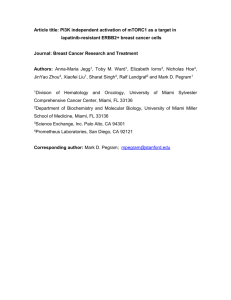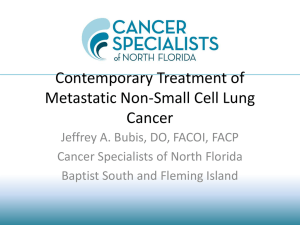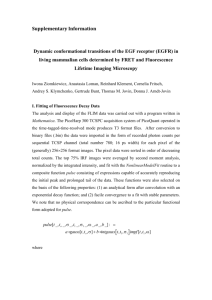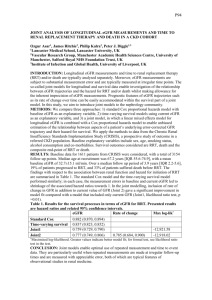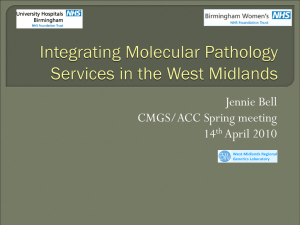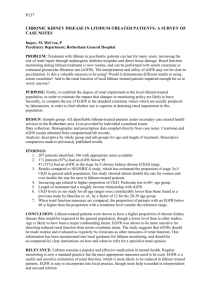Mutations, gene copy numbers, and protein expression of EGFR in
advertisement
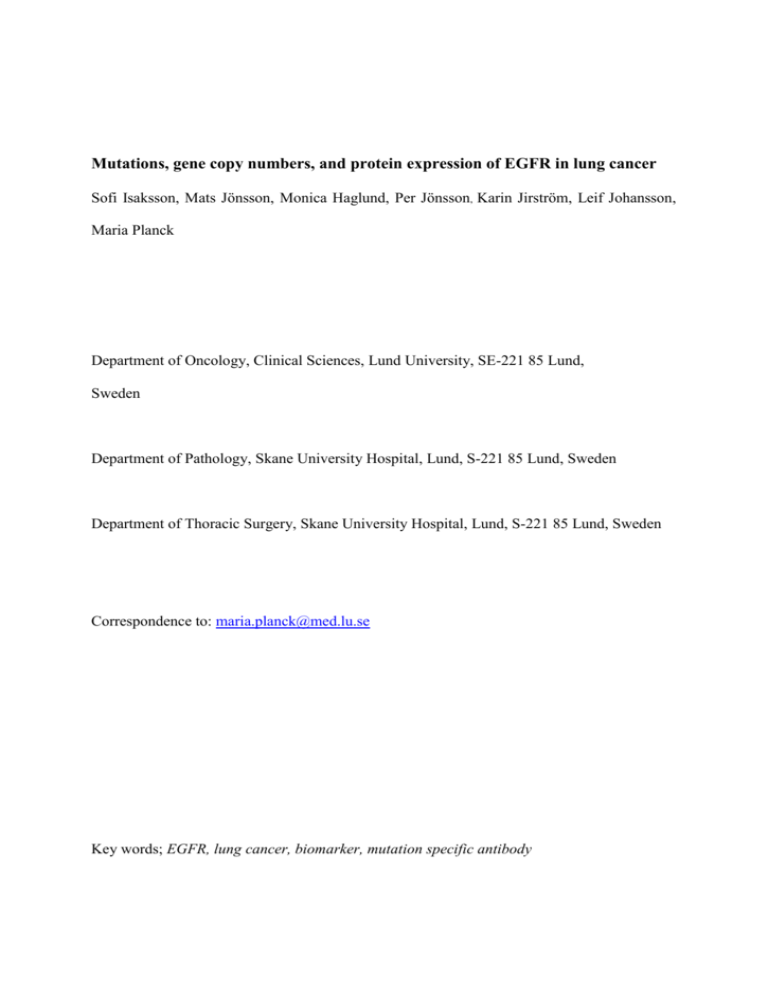
Mutations, gene copy numbers, and protein expression of EGFR in lung cancer
Sofi Isaksson, Mats Jönsson, Monica Haglund, Per Jönsson, Karin Jirström, Leif Johansson,
Maria Planck
Department of Oncology, Clinical Sciences, Lund University, SE-221 85 Lund,
Sweden
Department of Pathology, Skane University Hospital, Lund, S-221 85 Lund, Sweden
Department of Thoracic Surgery, Skane University Hospital, Lund, S-221 85 Lund, Sweden
Correspondence to: maria.planck@med.lu.se
Key words; EGFR, lung cancer, biomarker, mutation specific antibody
Abstract
Background: The epidermal growth factor receptor (EGFR) gene is a frequent oncogene in
lung cancer. Alterations of EGFR such as protein expression, gene copy numbers, mutations
and alterations in molecules acting downstream of EGFR might correlate in different ways.
Methods: Tissue microarrays (TMAs) with three cores from each of 369 surgically treated
NSCLCs were evaluated for EGFR protein expression by immunohistochemistry (IHC) and
for EGFR gene copy numbers by fluorescence in situ hybridising (FISH). The tumours were
scored as IHC 0-3+ and as FISH negative (non amplified) or positive (polysomy or
amplified). Both tests were evaluable for 334 cases. The two most frequent EGFR mutations,
exon 21 L858R and exon 19 E746-A750 deletion, were revealed with mutation-specific
antibodies on TMA and subsequently direct DNA sequencing. Results: IHC; 0 = 132, 1+ =
63, 2+ = 67, 3+ = 72. FISH; non amplified = 196, polysomy = 115, amplified = 23. All cores
containing viable tumour tissue could be evaluated for both tests. The correlation between
IHC and FISH was highly significant (p = 0.0007). EGFR IHC 1-3 was an adverse factor for
survival (p=0.02) but not EGFR FISH (p=0.35). 19 mutations consisting of 9 deletions and 10
substitutions were revealed with mutation-specific antibodies on TMA. Conclusions: Lung
cancer TMA is ideal for large biomarker studies by FISH and IHC. Furthermore, this study
confirms EGFR IHC over expression as a negative prognostic factor for survival and
demonstrates a highly significant correlation between EGFR FISH and IHC.
Introduction
Lung cancer is one of the most common malignancies and the leading cause of cancer death,
with an overall 5-year survival rate of less than 15%. EGFR, an important marker for
metastatic propensity and proliferation in lung cancer, is a 170 kDa transmembrane
glycoprotein and one of four members of the HER family of cell surface receptors and the
protein product of the oncogene HER1. Members of the HER family have an extracellular
ligand-binding area (except HER2), a hydrophobic transmembrane domain and an
intracellular region with tyrosine kinase activity. Ligands are growth factors such as EGF,
TGF- , amphiregulin, betacellulin and epiregulin. The binding of a ligand results in
autophosphorylation and downstream intracellular signalling. EGFR also plays a role in cell
motility, adhesion (through interaction of E-cadherin and the actin cytoskeleton), invasion and
angiogenesis (4).
EGFR is expressed or over expressed in a wide variety of solid human tumours, including
glioblastoma, prostate, breast, gastric, colorectal, head and neck, bladder and ovarian cancers,
and also in 50-70% of NSCLCs, whereas expression is weaker in normal lung tissue and in
small-cell lung cancer (5-7).
EGFR protein expression, EGFR gene copy number, occurrence of somatic EGFR mutations,
and alterations in genes acting downstream of EGFR in intracellular signalling have all been
suggested as predictive biomarkers for selecting patients to receive treatment with
EGFRTKIs, but no consensus regarding which marker would be the preferred choice has yet
been achieved (8-11).
We evaluated and correlated important EGFR alterations in 334 surgically resected NSCLCs.
More specifically we analyzed EGFR protein expression by IHC, gene copy numbers by
FISH and mutation status by IHC with mutation-specific antibodies detecting exon 21 L858R
and exon 19 E746-A750 deletion. To optimize the implementation of FISH (and IHC) on this
large series we performed high throughput tissue micro array (TMA)-based analyses of all
tumours. Tumours with mutations revealed with mutation –specific antibodies on IHC were
subsequently sequenced.
Materials and methods
The histopathological reports in two consecutive case series of patients, surgically treated for
Stage I–IIIA lung carcinoma at the University Hospital of Lund, were studied. The first series
of patients (n=187) was treated in 1981-83, the second (n=187) in 1995-97. None of the
patients had received any systematic neoadjuvant or adjuvant therapy. There were 241 (64%)
males and 133 (36 %) women; 25 % in the 1981-83 and 46% in the 1995-97 series. As to
histopathological subtypes; 148 (40%) cases were classified as squamous cell carcinoma, of
which 80% occurred in males; 135 (36%) cases were classified as adenocarcinoma, of which
53% occurred in males.
Immunohistochemistry
For this study the histopathological slides were reviewed and appropriate blocks identified
for construction of the TMAs (369 cases). Three 1.0 mm tissue cores were collected from
each tumour block and arranged in a recipient block using a manual tissue arrayer (Beecher
Inc., Sun Prairie, WI, USA). Semi-thin sections were cut from the paraffin blocks and stained
with hematoxylin and eosin (H&E) staining, and for EGFR IHC and FISH. EGFR protein
expression was evaluated by IHC, antibody NovoCastra (dilution 1:40), diluted
in Ab-dilution (S2022, Dako). Sections of 4μm were cut and dried for 2 hours at 60°C and
stored in 4°C until stained. Tissue sections were then deparaffinized in xylene and rehydrated
through graded alcohol and deionised water. For antigen retrieval, HIER (Heat Induced
Antigen Retrieval) was used, the sections were processed in an microwave oven, Milestone
TTMega, standard program for 80 slides (blank slides filled up to 80 when needed) in antigen
solution TRS pH 9,9 (S3307, Dako). Staining was performed in an automated immunostainer,
Techmate 500Plus (Ventana Biotek, Tucson, AZ) with standard procedure “ENVP”.
Visualization system was EnVision (art.no, K5007) from Dako, counterstaining with
Hematoxyline and dehydration in graded alcohol, xylene and mounted. Rinse buffer TBS, pH
7, 6 containing 0, 1% TWEEN (8.22184, Merck). Endogenous peroxidase was inactivated by
HP-Block (S 2023, Dako).
The staining was scored as 0 (negative), 1+ (weakly positive), 2+ (moderately positive) and
3+ (strongly positive). Positivity of any grade required staining in > 10% of the cell
membranes. All specimens were evaluated by one reader (LJ), and some results were also
confirmed by another reader (MH).
FISH
Copy number of the EGFR gene was determined by FISH using a dual-colour EGFR probe
(Vysis, Il USA) labelled with spectrum orange for EGFR (7p12) in combination with a
spectrum green for centromeric localisation (CEP7) as reference. Shortly, sections were
deparaffinized in xylen and 100% ethanol and air-dried, pretreated in pretreatment solution
(Abbott Vysis 2J06-30) for 10 min in 80°C water bath, Gant CD100 från VWR, and then
rinsed in distilled water for 3 min. Then 150 mg protease (Abbott Vysis 6J93-01) diluted in 37
ml protease buffer (Abbott Vysis art.no, 2J07-30) for 40 min in 37°C and rinsed in distilled
water for 3 min. Slides were then immersed in graded alcohol series (70%, 95% and 100%)
and air dried for 15 min. For hybridization 10 – 15 μl probe (EGFR SO/CEP7 SG DNA,
art.no, 5J48-01, Abbott Vysis) was applied to the hybridization area, which was covered with
a cover slip and sealed with rubber cement. For hybridization a semi-automated hybridizer,
ThermoBrite S 500-24 from Abbott Scandivavia AB, was used, i.e. denaturation in 85°C for 1
min and then hybridization overnight (16 – 20 h) at 37°C. Next morning the rubber cement
seal was stripped off and the cover slip removed. The specimens were washed in a
posthybridizing buffer (2XSSC/0,3% Igepal, prewarmed to +72°C) 2 min and rinsed in
distilled water. The slides were air dried in an upright dark position for 15 min. Ca 10 - 15 μl
mounting medium, Vectashield H1000 and H12000 (with DAPI) was mixed 1:1 and applied
onto the specimen and the area was covered with a coverslip and sealed with nail lacquer.
The specimens were evaluated in a Nikon Eclipse E80i fluorescence microscopes equipped
with 100 W mercury-arc lamp and fitted with high-quality objectives (10×, 40×, 60x, 100×) in
combination with dual (red/green) and single (blue) interference filters and an Olympus DP40 digital camera (1.5 milj pixel, 1392 x 1040). To be sure that the right core on the TMA was
evaluated in the fluorescence microscope a comparison was done continuously with a virtual
H&E slide of the same TMA scanned with an Aperio ScanScope CS System (courtesy of LRI
Imaging AB, Lund, Sweden). All specimens were evaluated by one reader (MH), and most
results were also confirmed by another reader (LJ). All difficult cases were discussed, and a
consensus was reached.
The results were scored, with slight modifications, according to the suggestions of VarellaGarcia (20) as negative; non amplified = usually 2-3 copies of the EGFR gene and
chromosome 7 or positive; amplified = number of EGFR gene copies/number of
chromosome 7 copies > 2, or polysomy > 3 copies (usually 4-12) of both the EGFR gene and
chromosome 7.
Statistical analysis
The Wilcoxon test was used for association between IHC and FISH. The Kaplan-Meier
analysis and log rank test were used to illustrate differences in overall survival (OS) according
to EGFR IHC and FISH.
Mutation-specific antibodies and immunohistochemistry
For mutation analysis two rabbit monoclonal antibodies (Cell Signaling, dilution 1:10) with
specificity for the exon 21 L858R and the exon 19 E746-A750 deletion respectively, were
used. Analyses were done on paraffin-embedded tissue microarrays.
The tumours were considered positive if staining was detected in at least one of the cores.
DNA extraction
Direct DNA sequencing
The tumours with positive staining as revealed with mutation specific antibodies were
sequenced using direct DNA sequencing. Mutations of exon 19 and 21 of the EGFR gene were
analysed by direct DNA sequencing using the BigDye Terminator Cycle Sequencing Kit v1.1
(Applied Biosystems®). The samples were initially purified and subsequently amplified. PCR was
performed in 10µL volumes using 80 ng (4µL 20ng/µL) template, 1, 75 µL 5xbuffer, 4 µL deionized
water and 0, 5 µL Terminator reaction mix. The mutations in exons 19 and 21 were determined using
primers described in supplementary table X. PCR was run under the following conditions; 25 cycles of
denaturation at 96°C for 10 s, primer annealing at 50°C for 5 s and elongation at 60°C for 1 min.
Sequencing products were separated by capillary electrophoresis by ABI 3130xl Genetic Analyzer
(Applied Biosystems®). Analysis of the sequencing was performed using the 3100 data collection
software (Gene Code Corporation®). The sequences were compared with XXX (genomisk EGFR).
Results
IHC and FISH
The results are given in table 1 and examples of positive staining in figure 1A-C. IHC staining
was negative (0+) in 132 (39.5%) cases, weakly positive (1+) in 63 (19%) cases, moderately
positive (2+) in 67 (20%) cases and strongly positive (3+) in 72 (21.5%) cases. FISH was
negative (non amplified) in 196 cases (59 %) and positive in 138 cases; 117 (34%) polysomy
(Figure 2A), 23 (7%) amplified (Figure 2B).
In 334 of the cases both tests were evaluable. The correlation between the two tests was
highly significant (p = 0.0007). Not only could IHC be evaluated for all these cases, but also,
the hybridizing was successful with all cores in the TMAs that contained viable tumour tissue.
Of the cases, 97 (29 %) were negative for both tests while 103 (31 %) were positive for both
tests.
Survival Kaplan-Meier plots showed that EGFR IHC positive cases (1-3+) had a significantly
worse survival compared to EGFR IHC negative cases (Figure 3A, p=0.02). When 3+ cases
were tested against 0-2+ cases, and 2-3+ cases against 0-1+ cases, the difference was not
significant (data not shown). A significant difference in survival between EGFR FISH
positive cases (polysomy, amplified) and EGFR FISH negative cases (non amplified) could
not be shown (Figure 4A, p=0.35).
Mutation-specific antibodies and IHC
Staining with the mutation-specific antibodies revealed in total 20 mutations of which 10 were
exon 19 deletions and 10 exon 21 substitutions. The tumours with mutations are presented in
table X with FISH and EGFR IHC status.
Confirmation of mutations by direct sequencing
Of the tumours positive in immunohistochemical analysis with the monoclonal antibodies
directed at the exon 21 L858R and the exon 19 E746-A750 deletion, respectively…
… infoga mutationsresultat efter sekvensering (Table x)
Discussion
Although the TMA technique has been applied in some studies of biomarkers in lung cancer
(18, 21), no systematic comparison between TMA and conventional slides as regards IHC has
been carried out, apart from a few small studies comparing EGFR IHC in biopsies and
resected specimens (22-23). Also, to our knowledge, the TMA technique has not been used
for assessment of EGFR FISH in lung cancer. However, HER2 FISH has been validated for
breast cancer (24), ovarian cancer (25) and for inter laboratory validation of FISH testing for
HER2 in breast cancer, using the TMA technique (26). Thus, it is reasonable to extrapolate
results for HER2 into EGFR, as the probes for HER2 and EGFR are very similar and, in this
case, from the same supplier. Finally, in our study, hybridizing was successful with all cores
in the TMAs that contained viable tumour tissue, which makes TMA an almost ideal
technique for biomarker studies with FISH in lung cancer. Thus, from a technical point of
view, the TMA technique is feasible for biomarker studies in lung cancer.
In 334 of the cases in our study both tests were evaluable and the correlation between IHC
and FISH was highly significant (Table 1, p = 0.0007). A previous study, with only 27 cases,
reported that EGFR IHC results were correlated with FISH results (P = 0.0125), but not with
prognosis (27). An association between EGFR FISH and EGFR IHC was also found by
Hirsch et al (16). They found that both FISH+ and IHC+ correlated with an improved survival
and that in multivariate survival analysis EGFR FISH and IHC were independent predictive
markers. We found 31% of the cases to be FISH+/IHC+ and 29% of the cases to be FISH/IHC-, which is comparable to the 23% and 30% reported by Hirsch et al (16). It has been
shown herein that both methods are reliable and valid as all cores in the TMA that contained
tumour tissue were evaluable with IHC as well as with FISH. Thus, from our study and from
previous studies it may be concluded that EGFR FISH and EGFR IHC can be reliably
performed and bear about the same kind of information. Thus, in analogy with the situation
for breast cancer and HER2, both may be included in a panel of tests (involving screening for
EGFR and KRAS mutations, and in the future perhaps MET amplification, AKT
phosphorylation as well as other markers) to receive therapy with TKIs.
In our study Kaplan-Meier plots showed that EGFR IHC positive cases (1-3+) had a
significantly worse survival compared to EGFR IHC negative cases (Figure 3A, p=0.02). A
significant difference in survival could not be found between EGFR FISH positive and
negative cases (Figure 4A, p=0.35). This is in agreement with Zheng et al (18), and with
Meert et al (5) who in a meta-analysis of 2,185 NSCLC patients found statistical significance
between EGFR expression and survival only in the subgroup of studies using IHC. However,
the result of another study of 262 cases has indicated that also EGFR FISH predicted worse
survival (19). When the 1981-83 and 1995-97 series of patients in our study were tested
separately for EGFR IHC significance remained only for the 1981-83 series. Surprisingly, this
association was also found for EGFR FISH in the 1981-83 series of patients. Thus, for the
1981-83 series of patients both EGFR IHC and FISH positivity was an adverse factor for
survival. The reason for this is not entirely clear, although the most likely explanation is a
covariation with TNM stage. Similar results have been reported very recently in a congress
abstract (28), were EGFR FISH was performed with TMA technique in a study of 356
NSCLC patients. A correlation was found between EGFR and progression of the T factor and
between EGFR genetic gain and amplification and tumour grade. It is well known that due to
the development and use of new medical technology clinical staging in the 80ies was not as
good as in the 90ies, leading to clinical understaging and more advanced stages treated by 8
surgery. The complete pTNM in our material is not known, and is presently not possible to
reconstruct.
When we tested males and females separately, males with EGFR IHC positivity had a
significantly worse survival (Figure 5, p=0,009) while no such difference was found for
females (Figure 5, p=0.80). Moreover, when IHC positivity was related to both decade and
gender there was still significance for males in the 1981-83 series (p=0.04, supplemental data)
and a strong tendency in the 1995-97 series (p=0.04, supplemental data). Thus, the adverse
effect of EGFR IHC positivity on survival in this study is confined to males. An explanation
might be that squamous cell carcinoma is overrepresented in males in our study (80%) and a
significant association between EGFR overexpression and lower differentiation grade and
node positivity has, for instance, been reported in head and neck squamous cell carcinomas
(29).
When males and females were tested separately for EGFR FISH positivity no difference with
respect to survival, neither among males (p=0.88, supplemental data) nor females (Figure 8,
p=0.14), was found. However, when FISH was related to decade and gender, surprisingly
there was a highly significant relation between FISH positivity and survival for females in the
1981-83 series (p=0.004, supplemental data) but not in the 1995-97 series (p=0.99,
supplemental data). The reason for this is unclear; however, only 25% of the cases in the
1981-83 series are women.
Data on EGFR protein expression, EGFR gene copy numbers and other markers for
responsiveness to EGFR-TKIs are conflicting. In several studies, EGFR mutations have been
strongly correlated with increased response rate and progression free survival in response to
erlotinib and gefitinib (9-10, 15). A significantly increased survival after TKI treatment in
patients whose tumours harbour EGFR mutations has also been reported by several
investigators, although a prognostic rather than predictive role for mutations has not been
ruled out (30). Furthermore, different localizations of mutations within the EGFR gene confer
different sensitivity to TKIs, with exon 19 deletions being associated with the best responses
and certain point mutations in exons 19 and 20 being linked to drug resistance (31). Thus,
additional prospective trials are needed to determine the positive and negative predictive
roles, respectively, of different EGFR mutations and also the impact of KRAS mutations,
which are associated with resistance to EGFR-inhibitors (11).
In response to gefitinib and erlotinib, high EGFR gene copy number (FISH-positive status)
has been significantly associated with increased tumour response rate, time to progression,
and better survival compared to patients without gain of EGFR and, furthermore, significantly
correlated with mutation status and clinical parameters that have been suggested previously as
predictors for benefit from TKI treatment (32). Most importantly, in participants from the
BR.21 trial, a significant overall survival benefit for erlotinib versus placebo was seen in
patients with FISH-positive tumours, but not in the FISH-negative patients (33) .
Early studies found no relationship between EGFR protein expression and benefit from
treatment with EGFR-inhibitors (12-14). However, in the BR.21 study, a survival
improvement for erlotinib versus placebo was demonstrated for patients whose tumours
showed EGFR protein expression by IHC, whereas no significant difference could be
demonstrated in the IHC-negative group (34). In agreement with the results from the BR.21
(34) (57%), ISEL (36) (69,6%) we found 60% positive staining for EGFR IHC, using 1+
staining intensity and staining in > 10% of the cell membranes as cut-off. Moreover, 10% cut
off has been reported to provide the best discrimination between EGFR-positive and
EGFRnegative patients for survival hazard ratios comparing gefitinib to placebo (36).
In summary, we found a highly significant correlation between increased EGFR gene copy
number and EGFR protein expression. Indeed, the main clinical question is who will not
benefit from treatment with EGFR-inhibitors and several groups have suggested that tumours
negative for both EGFR protein expression by IHC and for EGFR copy numbers by FISH are
unlikely to respond. Thus, in this perspective, a good correlation between these two methods
in our and other studies is of value since it admits a reliable identification of a group of
patients who will not benefit from treatment. The next group of lung cancer patients to be
excluded from treatment with EGFR-inhibitors is probably those whose tumours harbour
KRAS-mutations (11, 33), thus leaving only the relevant subgroup of cases that should be
selected for this treatment. Furthermore, the need for selecting NSCLC patients in large
clinical trials by biomarkers for EGFR status can be facilitated by use of TMA for
highthroughput analysis of protein expression by IHC or copy numbers by FISH in large
cohorts of patients.
References
1. Azzoli CG, Park BJ, Pao W, Zakowski M, Kris MG. Molecularly tailored adjuvant
chemotherapy for resected non-small cell lung cancer: a time for excitement and
equipoise. J Thorac Oncol. 2008;3:84-93.
2. Fukuoka M, Yano S, Giaccone G, Tamura T, Nakagawa K, Douillard JY et al.
Multiinstitutional
randomized phase II trial of gefitinib for previously treated patients with
advanced non-small-cell lung cancer (The IDEAL 1 Trial). J Clin Oncol. 2003;22372246. Epub 2003 May 14. Erratum in: J Clin Oncol. 2004;22:4811.
3. Shepherd FA, Rodrigues Pereira J, Ciuleanu T, Tan EH, Hirsh V et al. Erlotinib in
previously treated non-small-cell lung cancer. N Engl J Med. 2005;353:123-132.
4. de Jong JS, van Diest PJ, van d Valk P, Baak JP. Expression of growth factors,
growth-inhibiting factors, and their receptors in invasive breast cancer. II: Correlations
with proliferation and angiogenesis. J Pathol 1998;184:53–57.
5. Meert AP, Martin B, Delmotte P, Berghmans T, Lafitte JJ, Mascaux C et al. The role
of EGF-R expression on patient survival in lung cancer: a systematic review with
meta-analysis. Eur Respir J. 2002;20:975-981.
6. Swinson DE, Cox G, O'Byrne KJ. Coexpression of epidermal growth factor receptor
with related factors is associated with a poor prognosis in non-small-cell lung cancer.
Br J Cancer. 2004;91:1301-1307.
7. Tsao MS, Sakurada A, Cutz JC, Zhu CQ, Kamel-Reid S, Squire J et al. Erlotinib in
lung cancer - molecular and clinical predictors of outcome. N Engl J Med.
2005;353:133-144. Erratum in: N Engl J Med. 2006;355:1746.
8. Sequist LV, Dziadziuszko R. Update on epidermal growth factor receptor inhibitor
development in lung cancer. J Thorac Oncol. 2006 Sep;1(7):740-3.
9. Paez JG, Jänne PA, Lee JC, Tracy S, Greulich H, Gabriel S et al. EGFR mutations
in lung cancer: correlation with clinical response to gefitinib therapy. Science.
2004;304:1497-1500. Epub 2004 Apr 29.
10. Pao W, Miller V, Zakowski M, Doherty J, Politi K, Sarkaria I et al. EGF receptor
gene mutations are common in lung cancers from "never smokers" and are associated
with sensitivity of tumors to gefitinib and erlotinib. Proc Natl Acad Sci U S A.
2004;101:13306-13311. Epub 2004 Aug 25.
11. Pao W, Wang TY, Riely GJ, Miller VA, Pan Q, Ladanyi M et al. KRAS mutations
and primary resistance of lung adenocarcinomas to gefitinib or erlotinib. PLoS Med.
2005;2:e17. Epub 2005 Jan 25.
12. Bailey LR, Kris M, Wolf M, et al: Tumor EGFR membrane staining is not clinically
relevant for predicting response in patients receiving Gefitinib (Iressa, ZD1839)
monotherapy for pretreated advanced non-small-cell lung cancer: IDEAL 1 and 2.
Proc Am Assoc Cancer Res 44. 2003;(abstr LB-170).
13. Parra HS, Cavina R, Latteri F, Zucali PA, Campagnoli E, Morenghi E et al.
Analysis of epidermal growth factor receptor expression as a predictive factor for
response to gefitinib ('Iressa', ZD1839) in non-small-cell lung cancer. Br J Cancer.
2004;91:208-212.
14. Bailey LR, Janas M, Schmidt K, Bindslev N, Wolf M, Grous J, et al. Evaluation of
epidermal growth factor receptor (EGFR) as a predictive marker in patients with nonsmallcell lung cancer (NSCLC) receiving first-line gefitinib combined with platinumbased
chemotherapy. J Clin Oncol. 2004;22:7013.
15. Cappuzzo F, Hirsch FR, Rossi E, Bartolini S, Ceresoli GL, Bemis L et al. Epidermal
growth factor receptor gene and protein and gefitinib sensitivity in non-small-cell lung
cancer. J Natl Cancer Inst. 2005;97:643-655. 11
16. Hirsch FR, Varella-Garcia M, Cappuzzo F, McCoy J, Bemis L, Xavier AC et al.
Combination of EGFR gene copy number and protein expression predicts outcome for
advanced non-small-cell lung cancer patients treated with gefitinib. Ann Oncol.
2007;18:752-760. Epub 2007 Feb 22.
17. Buckingham LE, Coon JS, Morrison LE, Jacobson KK, Jewell SS, Kaiser KA et al.
The prognostic value of chromosome 7 polysomy in non-small cell lung cancer
patients treated with gefitinib. J Thorac Oncol. 2007;2:414-422.
18. Zheng H, Saito H, Masuda S, Yang X, Takano Y. Phosphorylated GSK3beta-ser9 and
EGFR are good prognostic factors for lung carcinomas. Anticancer Res.
2007;27:3561-3569.
19. Jeon YK, Sung SW, Chung JH, Park WS, Seo JW, Kim CW, Chung DH.
Clinicopathologic features and prognostic implications of epidermal growth factor
receptor (EGFR) gene copy number and protein expression in non-small cell lung
cancer. Lung Cancer. 2006;54:387-398. Epub 2006 Sep 29.
20. Varella-Garcia M. Stratification of non-small cell lung cancer patients for therapy
with epidermal growth factor receptor inhibitors: the EGFR fluorescence in situ
hybridization assay. Diagn Pathol. 2006;1:19.
21. Nitadori J, Ishii G, Tsuta K, Yokose T, Murata Y, Kodama T et al.
Immunohistochemical differential diagnosis between large cell neuroendocrine
carcinoma and small cell carcinoma by tissue microarray analysis with a large
antibody panel. Am J Clin Pathol. 2006;125(5):682-692.
22. Meert AP, Martin B, Verdebout JM, Paesmans M, Berghmans T, Ninane V, Sculier
JP. Correlation of different markers (p53, EGF-R, c-erbB-2, Ki-67) expression in the
diagnostic biopsies and the corresponding resected tumors in non-small cell lung
cancer. Lung Cancer. 2004;44:295-301.
23. Taillade L, Penault-Llorca F, Boulet T, Fouret P, Michiels S, Taranchon E et al.
Immunohistochemichal expression of biomarkers: a comparative study between
diagnostic bronchial biopsies and surgical specimens of non-small-cell lung cancer.
Ann Oncol. 2007;18:1043-1050. Epub 2007 Mar 12.
24. Bhargava R, Lal P, Chen B. Feasibility of using tissue microarrays for the assessment
of HER-2 gene amplification by fluorescence in situ hybridization in breast
carcinoma. Diagn Mol Pathol. 2004;13:213-216.
25. Mayr D, Kanitz V, Amann G, Engel J, Burges A, Löhrs U, Diebold J. HER-2/neu
gene amplification in ovarian tumours: a comprehensive immunohistochemical and
FISH analysis on tissue microarrays. Histopathology. 2006;48:149-156.
26. Diaz LK, Gupta R, Kidwai N, Sneige N, Wiley EL. The use of TMA for
interlaboratory validation of FISH testing for detection of HER2 gene amplification in
breast cancer. J Histochem Cytochem. 2004;52:501-507.
27. Sasaki H, Endo K, Okuda K, Kawano O, Kitahara N, Tanaka H et al. Epidermal
growth factor receptor gene amplification and gefitinib sensitivity in patients with
recurrent lung cancer. J Cancer Res Clin Oncol. 2008;134:569-577. Epub 2007 Oct
12.
28. Cherneva R. Tissue microarray analysis of EGFR copy number changes I non-small
cell lung cancer – Correlation with clinico-pathological parameters. J Thor Oncol
2008;3:S36.
29. Sheikh Ali MA, Gunduz M, Nagatsuka H, Gunduz E, Cengiz B, Fukushima K et al.
Expression and mutation analysis of epidermal growth factor receptor in head and
neck squamous cell carcinoma. Cancer Sci. 2008;99:1589-1594. 12
30. Uramoto H, Mitsudomi T. Which biomarker predicts benefit from EGFR-TKI
treatment for patients with lung cancer? Br J Cancer. 2007;96:857-863. Epub 2007
Feb 27.
31. van Zandwijk N, Mathy A, Boerrigter L, Ruijter H, Tielen I, de Jong D et al. EGFR
and KRAS mutations as criteria for treatment with tyrosine kinase inhibitors: retroand
prospective observations in non-small-cell lung cancer. Ann Oncol. 2007;18:99103. Epub 2006 Oct 23.
32. Takano T, Ohe Y, Sakamoto H, Tsuta K, Matsuno Y, Tateishi U et al. Epidermal
growth factor receptor gene mutations and increased copy numbers predict gefitinib
sensitivity in patients with recurrent non-small-cell lung cancer. J Clin Oncol.
2005;23:6829-6837. Epub 2005 Jul 5.
33. Zhu CQ, da Cunha Santos G, Ding K, Sakurada A, Cutz JC, Liu N et al. National
Cancer Institute of Canada Clinical Trials Group Study BR.21. Role of KRAS and
EGFR as biomarkers of response to erlotinib in National Cancer Institute of Canada
Clinical Trials Group Study BR.21. J Clin Oncol. 2008;26:4268-4275. Epub 2008 Jul
14.
34. Tsao M-S, Sakurada A, Cutz J-C, et al. Erlotinib in lung cancer—molecular and
clinical predictors of outcome. N Engl J Med. 2005;353:133–144.
35. Hirsch FR, Varella-Garcia M, Bunn PA, et al. Molecular predictors of outcome with
gefitinib in a phase III placebo-controlled study in advanced non-small-cell lung
cancer. J Clin Oncol. 2006;24:5034–5042.
36. Hirsch FR, Dziadziuszko R, Thatcher N, Mann H, Watkins C, Parums DV et al.
Epidermal growth factor receptor immunohistochemistry: comparison of antibodies
and cutoff points to predict benefit from gefitinib in a phase 3 placebo-controlled
study in advanced nonsmall-cell lung cancer. Cancer. 2008;112:1114-1121.
13
Legends to the figures.
Figure 1A. Immunohistochemistry for EGFR. NSCLC with weak (1+) EGFR staining.
Figure 1B. Immunohistochemistry for EGFR. NSCLC with moderate (2+) EGFR staining.
Figure 1C, Immunohistochemistry for EGFR. NSCLC with strong (3+) EGFR staining.
Figure 2A. Fluorescence in situ hybridising (FISH) with polysomy. Equal number of signals
for the EGFR gene (orange) and CEP7 (green). Nuclei stained with DAPI.
Figure 2B. Fluorescence in situ hybridising (FISH) with amplification. Clusters of signals for
the EGFR gene (orange) and two signals for CEP7 (green). Nuclei stained with DAPI.
Figure 3. Survival, IHC positive compared to IHC negative. A all patients, B 1981 -83 series,
C 1995 – 97 series.
Figure 4. Survival, FISH positive compared to FISH negative. A all patients, B 1981 -83
series, C 1995 – 97 series.
Figure 5. Comparison between IHC/FISH and gender.
Figure 6 (supplemental data). IHC comparison decade/gender
Figure 7 (supplemental data). FISH comparison decade/gender
TABLE x
Tumor
Histology
Mutationspecific IHC*
Direct DNA
sequencing (exon 19
and 21)**
IHC***
FISH*
***
1
delE746-A750
3
2
2
delE746-A750
1
1
3
delE746-A750
1
1
4
delE746-A750
1
1
5
delE746-A750
0
0
6
delE746-A750
1
1
7
delE746-A750
0
0
8
delE746-A750
2
0
9
delE746-A750
2
1
10
L858R
0
0
11
L858R
1
1
12
L858R
2
1
13
L858R
2
1
14
L858R
3
2
15
L858R
3
2
16
L858R
1
1
17
L858R
3
2
18
L858R
3
2
19
L858R
0
1
